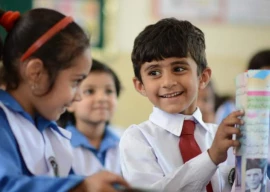
Two doctors evacuating the sick had to be airlifted to safety after getting trapped on the top floor of the district hospital, the main source of health care for 1.6 million people in the district.
“Eighty per cent of the hospital staff were affected themselves. The water had destroyed their homes, cars and everything. No one was able to come to the hospital,” said the hospital’s medical superintendent, Muhammad Arshad.
But since the devestation, caused by monsoon-triggered floods which swept across the country, a massive volunteer undertaking has allowed the hospital to reopen, and Arshad now sits smiling on donated furniture in his freshly whitewashed office.
The walls that were blackened and buried in mud for a week are now a hygienic white, there are working heart-monitor, X-ray, ultrasound and anesthaesia machines, and the damaged water pipe has been replaced.
“When we arrived to rehabilitate the hospital we had no idea where to start, because every corner of the hospital needed immediate attention,” said Arif Mehmood Siddiqui, the administrative head of the National University of Science and Technology, who coordinated the volunteer effort.
“What we had was mud and a stinking smell. There was not even a bench to sit on to run a clinic,” he says.
Young doctors from Rawalpindi arrived with doctors from international aid organisation Medecins Sans Frontieres, army engineers and university staff, to roll up their shirt sleeves and save the hospital.
Now, after hard work and donations, the hospital has new mattresses and pillows for all 114 beds, there are new delivery tables for the labour ward and the operating theatres are fully functioning.
“We have rediscovered this hospital from the rubble,” Siddiqui said.
Once the hospital itself had been saved, however, there were hundreds of flood victims waiting for help – meaning extra doctors were quickly needed.
“We ran this hospital for two weeks because the doctors normally on duty were affected themselves. There was a dire need for doctors and medicine and we successfully managed it,” said Dr Nasir Habib of Rawalpindi.
The World Health Organisation estimates that 4.4 million flood victims have received medical treatment since the floods began in late July, but that number only accounts for those who visited health centres that reported their figures.
Before the floods, this district hospital handled up to 400 patients each day, but Arshad says nearly 700 now come daily.
Many of them are suffering from water-borne gastric diseases caused by the month-long floods, which threaten to cause a second wave of death among the 18 million affected nationwide.
“Everything is under control, we are ready to fight diarrhoea and can deal with the patient load,” said Dr Fayaz Ahmed, who runs a clinic to counter the diarrhoea epidemic.
For Nabila, whose two-month-old daughter was struck with the illness, the work of the volunteers has saved her family.
“These doctors have given new life to my daughter. I am so thankful to this hospital which has saved my baby from death,” Nabila said.
For Shumaila Khatoon, a 29-year-old woman who is due to give birth next month, the reopening of the hospital has brought much-needed relief. “I am really relieved. Now I can give birth to my baby without worry,” she said.
Published in The Express Tribune, September 4th, 2010.










1732534225-0/Express-Tribune-(13)1732534225-0-270x192.webp)






COMMENTS (2)
Comments are moderated and generally will be posted if they are on-topic and not abusive.
For more information, please see our Comments FAQ